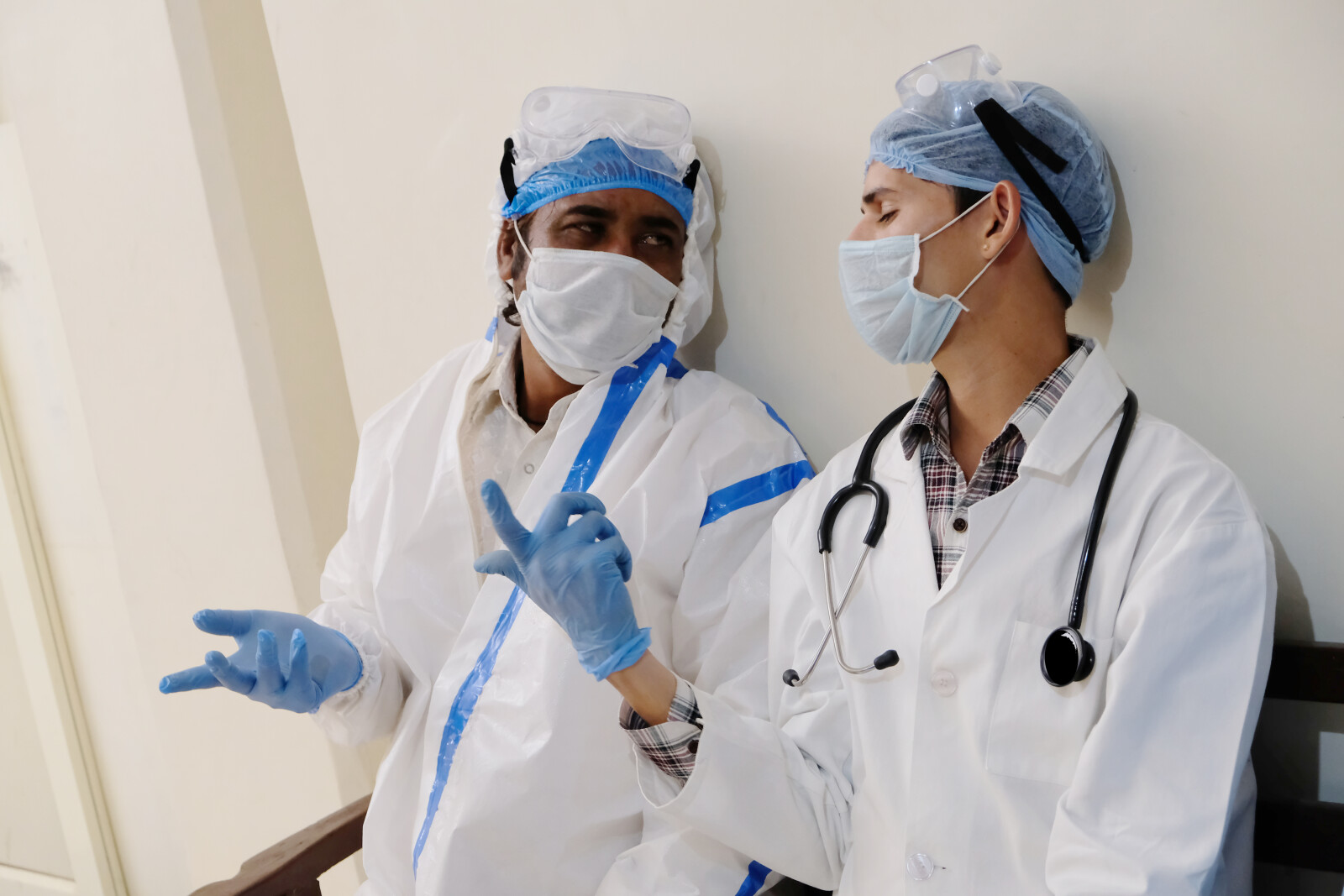Healthcare Workers Face Alarming Injury Rates
In the healthcare sector, professionals face injury risks thrice as high as construction workers, with an estimated 653,000 annual falls. Back injuries, musculoskeletal disorders, and needle sticks are common, while workplace violence significantly contributes to these numbers. Despite the risks, oversight remains inadequate. This article explores the high injury rates among healthcare workers, their causes, and potential preventative strategies, emphasizing the urgent need for improved safety measures in this rapidly growing industry.

Key Takeaways
- Healthcare workers experience a significantly higher rate of injuries compared to workers in the manufacturing industry.
- Back injuries, musculoskeletal disorders, needle sticks, violence, and head injuries are common accidents and injuries in the healthcare industry.
- The number of healthcare workers is growing rapidly, and more safety measures are needed to ensure a safer working environment.
- There is a lack of safety measures, inspections, and regulations in the healthcare industry, which needs to be addressed to reduce injuries and their costs.
The Stark Reality: Comparing Injury Rates in Healthcare and Other Industries
Alarmingly often, healthcare workers face higher rates of injuries compared to other industries, highlighting the stark reality of safety issues in the healthcare sector. Training plays a pivotal role in reducing these injuries. A well-designed training program can equip healthcare workers with the requisite knowledge and skills to perform their duties safely, thereby reducing the risk of injuries. Moreover, the advent of automation in the healthcare sector has opened up new opportunities for enhancing worker safety. Automated technologies can handle repetitive tasks, reducing physical strain and the associated risk of musculoskeletal disorders. Additionally, automation can prevent needle stick injuries by safely disposing of used needles. Thus, a combination of effective training and automation can significantly enhance safety in the healthcare sector.
Identifying the Common Accidents and Injuries in Healthcare
In the realm of healthcare, professionals frequently encounter a variety of occupational hazards, with common accidents like needle sticks and back injuries significantly contributing to the overall risk profile. Back injuries, often caused by patient handling tasks, have a notable financial impact, and needle sticks can transmit blood-borne diseases. The repercussions extend beyond the individual, as the impact of injuries on patient care can be significant, due to reduced staff availability and potential for error. Prevention strategies are paramount, encompassing ergonomic intervention and rigorous safety protocols. Training in correct manual handling techniques and the use of safety-engineered devices can lessen the risk of needle sticks. By prioritizing worker safety, healthcare institutions can enhance patient care quality.
The Role of Demographics in Healthcare Worker Injuries
With over 18 million workers, 80% of whom are women, the healthcare industry showcases a unique demographic profile, and this plays a significant role in understanding the high prevalence of occupational injuries and the necessity for tailored safety measures. The role of gender cannot be dismissed as women often undertake physically demanding tasks like patient lifting, increasing their susceptibility to musculoskeletal disorders. The impact of the aging population, both as healthcare providers and recipients, is another key consideration. Older employees may face higher injury risks, while an aging patient population requires more intensive care. The demographics in healthcare not only highlight the critical need for gender-specific and age-appropriate safety protocols but also emphasize the importance of ongoing research in this area.
Exploring the Growth of the Healthcare Industry
The healthcare industry, marked by rapid expansion and an increasing workforce, has been witnessing significant growth, yet it is grappling with the urgent need for enhanced safety measures and regulations. As the industry continues to expand, it is crucial to explore future challenges, particularly those concerning workers' safety. The elevated injury rates among healthcare workers demand immediate attention as it directly impacts patient care. A safer work environment ensures enhanced service quality, fostering trust and satisfaction among patients. Therefore, prioritizing workers' safety by implementing stringent regulations and regular inspections is not just a matter of ethical responsibility, but also a strategic move towards sustainable growth. The industry must act promptly to address these concerns to ensure its continued progress and the well-being of its workforce.
Unveiling the Lack of Safety Measures in Healthcare
Alarming statistics reveal a stark lack of safety measures in the healthcare sector, leading to an urgent call for action to enhance safety protocols and protect healthcare workers. Exploring workplace hazards, we find that healthcare workers face unique dangers, from needle-stick injuries to musculoskeletal disorders due to repetitive stress. Examining safety training programs, there is an evident need for comprehensive schemes that address these specific risks. Despite healthcare being a fast-growing sector, it's concerning how it lags behind in safety regulations and inspections compared to industries like construction. The high injury rates and the tremendous financial implications of these injuries underscore the urgent need for targeted interventions, effective safety training programs, and stringent enforcement of safety measures in the healthcare industry.
The Crucial Need for More Inspections in Healthcare
In light of the alarming injury rates among healthcare workers, there exists an urgent need for increased inspections in healthcare facilities, and this need is further underscored by the relatively lower frequency of inspections compared to other industries like construction. The number of healthcare workers exposed to potential hazards is significantly climbing, leading to a crucial call for increasing safety measures. Promotion of workplace wellness, augmented by regular inspections, could lead to a significant reduction in injury rates. Strict implementation of safety regulations, effective safeguarding protocols, and a comprehensive approach to workplace wellness are all paramount. Thus, an immediate response to this issue can ensure a safer, healthier work environment, ultimately contributing to the quality of patient care and the overall efficiency of the healthcare system.
The High Cost of Injuries in the Healthcare Industry
We must closely examine the severe financial implications of injuries in the healthcare industry, as they not only burden the injured employees but also significantly impact the overall economic health of this sector. Healthcare worker injuries have a profound economic impact, estimated at billions of dollars annually, which includes lost productivity, increased insurance premiums, and workers' compensation payments. The role of safety training in reducing healthcare worker injuries is paramount. A comprehensive safety training program can help prevent accidents, reduce the severity of injuries, and promote a culture of safety. This not only enhances the wellbeing of healthcare workers, but also contributes to the financial stability of the sector. A safer workplace is a more efficient and economically stable one, benefiting employees, employers, and patients alike.
The Importance of Prevention and Support in Healthcare
Prevention and support in healthcare are crucial, not only to reduce the risk of workplace injuries but also to provide the necessary aid to those who have been adversely affected by such incidents. Preventing workplace accidents in medical settings is key, as healthcare workers are at a higher risk for injuries compared to other industries. These injuries often range from musculoskeletal disorders due to repetitive stress, to more severe cases such as needle sticks and violence in the workplace. Moreover, supporting healthcare workers' well-being is equally significant. It includes addressing mental health issues prevalent in this sector, and ensuring workers' compensation benefits for those injured. Essentially, a holistic approach incorporating both prevention of accidents and support for workers is vital for a safer healthcare industry.
Addressing Mental Health Issues Among Healthcare Workers
Amid the physically demanding work environment, the mental health of healthcare workers requires serious attention due to the high-stress levels and emotional burden associated with their line of work. Mental health support for these professionals is crucial to ensure their well-being and optimal job performance. Workplace safety measures are equally significant to prevent physical injuries, but must also address the psychological toll that ensues. With the healthcare industry's rapid growth, it's paramount that institutions prioritize these issues. This includes the implementation of regular mental health assessments, fostering a supportive work environment, and offering counselling services. Furthermore, healthcare facilities should establish clear protocols to mitigate work-related stress. By doing so, we can secure an environment conducive to both the physical and mental health of our healthcare workers.
The Path to Compensation for Injured Healthcare Workers
Frequently, injured healthcare workers face complex and lengthy processes when seeking the compensation they are entitled to, highlighting the urgent need for system-wide improvements. The importance of workers' compensation for healthcare workers cannot be overstated; it provides essential financial support during recovery. However, the process often requires navigating intricate legal and medical jargon, causing additional stress. To simplify this, seeking legal representation for healthcare worker injuries is advisable. Experienced lawyers can translate the complex language, ensuring workers fully understand their rights and obligations. As the healthcare industry continues to grow, prioritizing workers' compensation and providing adequate legal support becomes even more critical. It's high time to streamline the process, and prioritize the wellbeing of our healthcare workers.
Frequently Asked Questions
What Specific Training Programs Are Available to Educate Healthcare Workers About Injury Prevention?
Training programs for healthcare workers often incorporate workplace ergonomics and hazard identification to prevent injuries. These programs focus on correct body mechanics, safe patient handling, and reducing repetitive stress injuries. Additionally, they educate workers on identifying potential hazards, such as slippery floors or improperly disposed sharp objects. These educational initiatives aim to foster a safer work environment and reduce the high injury rates prevalent in the healthcare industry.
How Are Healthcare Facilities Addressing the Issue of Violence Against Their Employees?
Healthcare facilities are implementing Employee Support Systems and Policy Reforms to address violence against their personnel. These include de-escalation training, enhanced security measures, and stringent reporting protocols for violent incidents. There's a growing emphasis on creating a culture of safety, and reforms are fostering an environment where employees feel secure in reporting threats or acts of violence. Additionally, support systems focus on providing necessary assistance and counseling to affected employees, underscoring the industry's commitment to worker safety.
What Are Some of the Reasons That OSHA Performs Fewer Inspections in Healthcare Facilities Compared to Other Industries?
OSHA's limitations in conducting inspections in healthcare facilities often stem from their criteria prioritizing industries with high immediate injury rates, like construction or manufacturing. The subtle, long-term injuries common in healthcare, such as musculoskeletal disorders or stress-related ailments, may not trigger OSHA's immediate inspection criteria. Additionally, the vast scope and diversity of healthcare facilities further complicate the inspection process. Hence, there is a pressing need for more tailored safety regulations and rigorous inspections in the healthcare sector.
Are There Any Specific Safety Measures That Have Proven to Be Particularly Effective in Reducing Injury Rates in the Healthcare Industry?
Ergonomic equipment usage has been particularly effective in reducing injury rates in the healthcare industry. This includes adjustable beds, mechanical patient lifts, and updated medical tools designed to minimize strain. Additionally, robust workers' compensation policies, which ensure injured workers receive adequate care and time for recovery, deter rushing or bypassing safety protocols. Both measures contribute to a safer work environment, ultimately reducing injury rates.
How Does the Injury Rate Among Healthcare Workers Compare to That of Other High-Risk Jobs, Such as Mining or Logging?
Healthcare workers face substantial injury rates, often surpassing those of high-risk sectors like mining or logging. This can be attributed to factors such as physical strain from patient handling, needlestick injuries, and workplace violence. The consequential impact is not just physical, but also leads to significant psychological distress. It's imperative that these workers are adequately compensated for injuries sustained, and preventive measures are enhanced to ensure their safety.
Conclusion
In conclusion, the escalating injury rates among healthcare workers underscore the critical need for rigorous safety measures and proactive prevention strategies. Addressing these concerns will not only safeguard the wellbeing of the healthcare workforce but also enhance the quality of patient care. Therefore, it is imperative for regulatory bodies to intensify inspections, enforce stricter safety guidelines, and facilitate comprehensive support systems, including mental health resources, to ensure safer, healthier work environments in the healthcare industry.

This post has been generated by AI and was not reviewed by editors. This is Not legal advice. Please consult with an attorney.




